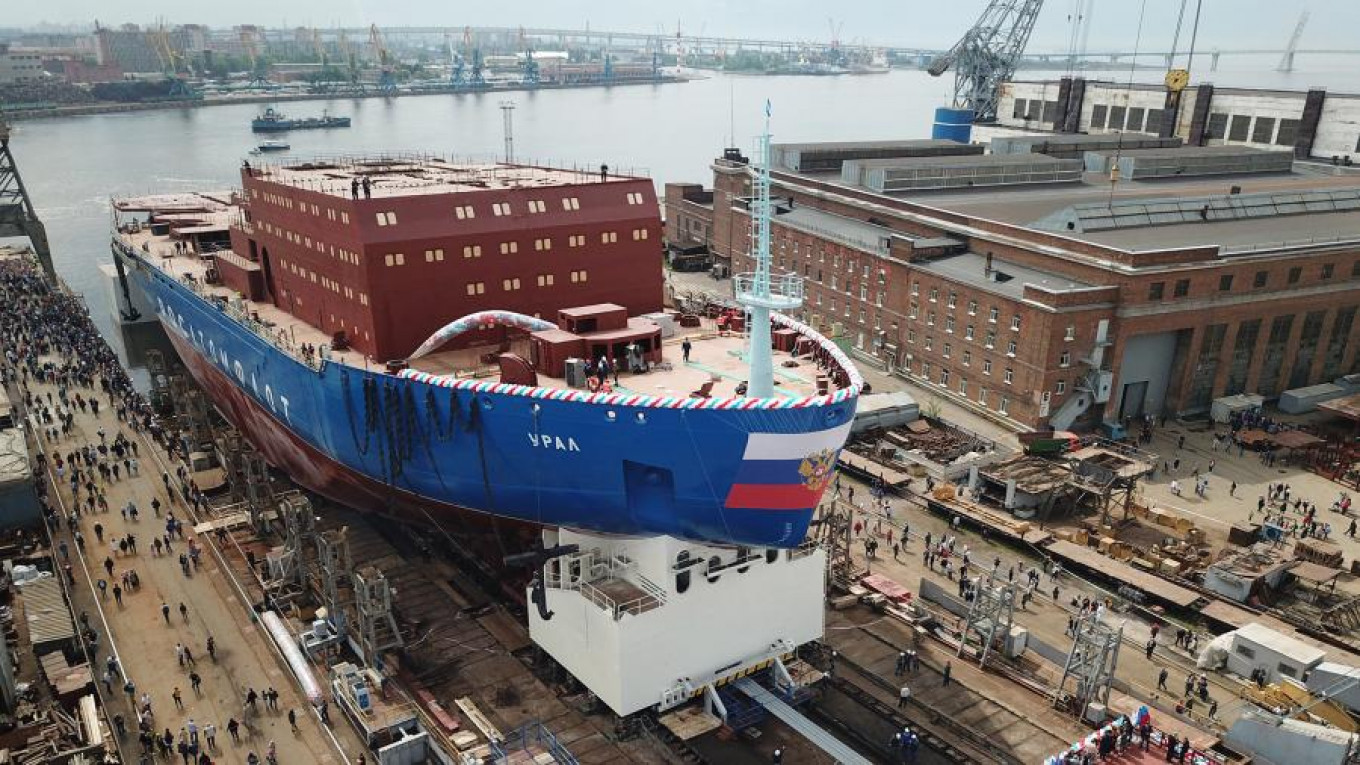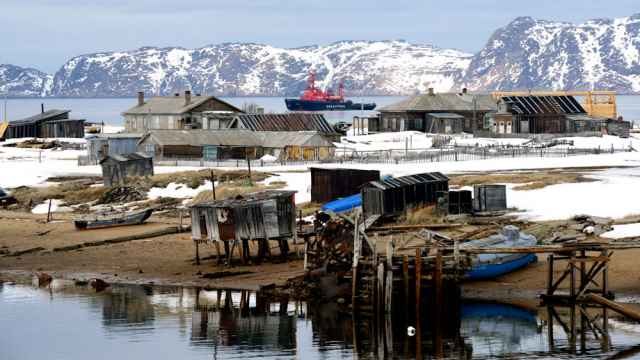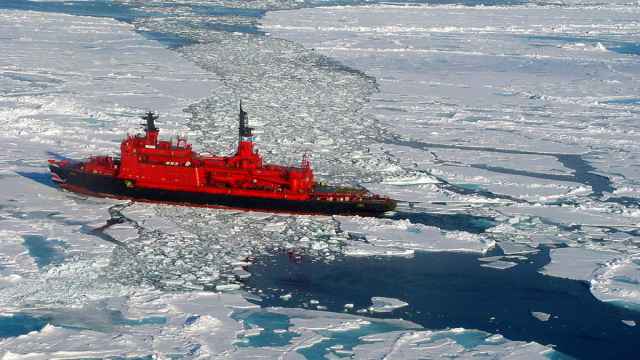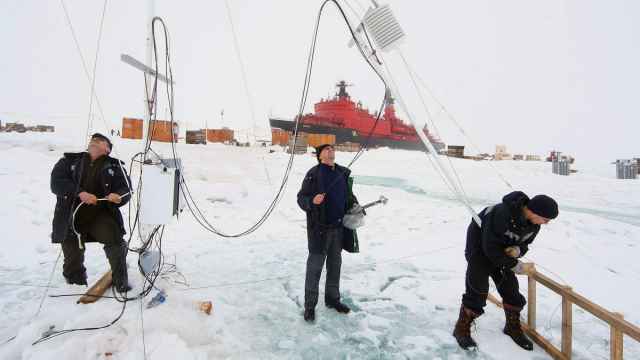Last weekend, Russia launched the last of a new crew of atomic icebreakers meant to consolidate the country’s dominance of commercial traffic in the Arctic. As much of the rest of the world recognizes climate change as an emergency, Russia is working hard to capitalize on it — and the U.S. appears to be far behind.
The icebreaker Ural, launched at the Baltic Shipyard in St. Petersburg, is the third and last ship, at least for now, of Project 22220. The other two, the Arktika and the Sibir, were launched in 2016 and 2017; the Arktika is expected to enter service this year. These powerful ships, capable of crashing through 3-meter-thick ice for clearing shipping routes, are the first nuclear-powered icebreakers designed in Russia since the collapse of the Soviet Union and fully built in post-Soviet times. The current nuclear icebreaker fleet is old, mostly built in the 1970s and 1980s, and much of it is no longer functional. The Russian government aims to replace it with the new giant ships in order to make what Russia calls the Northern Sea Route navigable year-round, not just a few months a year.
The Northern Sea Route tracks Russia’s Arctic coastline from the Barents Sea in the west to the Bering Strait in the east. It cuts cargo delivery times between Europe and Asia by 10 to 15 days compared to shipping via the Suez Canal. The Russian government claims the right to regulate the whole of the route, even though not all of it passes through the country’s territorial waters, defined as 200 nautical miles from its shores.
The Russian insistence that all Arctic traffic requires Moscow’s permission long has been an irritant to the U.S. Russia, meanwhile, has invested in opening and reopening military bases along its Arctic coast. Ten disused military airfields have been reopened, and 13 more are being built. By now, the bases cover almost the entire coastline and are, if required, ready to protect or disrupt any traffic along the North Sea Route. In a classic case of great power competition — who’s got more hardware? — the U.S. faces an “icebreaker gap” compared with Russia.
The reason for this gap may well lie in the two countries’ different approaches to climate change. The U.S. oscillates between recognizing it as an emergency and, most recently under President Donald Trump, full-on skepticism. Russian President Vladimir Putin, for his part, has expressed doubt that human activity is causing climate change, but he doesn’t deny that it’s taking place.
Putin’s attitude is that people can’t do much to stop climate change, and that makes adapting to it a long game. While he recognizes that the frequent droughts and floods that come with climate change can hurt Russian agriculture, he also sees the opportunities that come with a warmer climate, including a more navigable Arctic Ocean.
The U.S. Navy has estimated that, despite the gradual melting of the ice cap, the Arctic “will remain impassable for most commercial ships for most of the year” at least until 2030 due to the unpredictable movement of sea ice. The Kremlin has decided against waiting this long, moving simultaneously to secure the Northern Sea Route by investing in the new icebreaker fleet (the Project 22220 ships are built by a state company) and building railroad lines to the Arctic and commercial ports on the coastline. In April, Russian government officials told a conference that the plan is to increase cargo traffic along the Northern Sea Route to 92.6 million metric tons by 2024 from 20.2 million tons in 2018; the cargo traffic was only half that in 2017.
So far, the growth mainly has been achieved thanks to energy major Novatek PJSC’s new liquefied gas project in the Yamal Peninsula: The company exports LNG to Asian, mainly Chinese, clients along the Northern Sea Route. Eventually, though, the Russian government also hopes to move more of other commodities, such as oil and coal, along Arctic shipping lanes.
All these ambitious plans are, in effect, a bet that by the time climate change helps make the Northern Sea Route navigable all year, Russia will have full control of any through traffic on the route — and will be actively exploiting it for its own commodity exports, shortening their path to Asia.
The strategic bet isn’t easy for anyone, even the U.S. with its naval power, to counter without a direct military confrontation because Russia is already so far ahead. Russia cannot afford to keep up with major rivals in all areas; as it worked on putting some distance between itself and other Arctic powers, it was squandering, for example, its advantage in space launches. But for Putin, the Northern Sea Route is a bigger priority — and one of the few things it can offer China in the anti-U.S. alliance he’s trying to build with President Xi Jinping.
So far, racing to assert Russian power in the Arctic before climate change makes competition there a free-for-all appears to have worked for the Kremlin. Western countries with access to the Arctic, European as well as North American, have been too slow — and perhaps not cynical enough — to bet as big as Putin has.
This article was originally posted by Bloomberg
A Message from The Moscow Times:
Dear readers,
We are facing unprecedented challenges. Russia's Prosecutor General's Office has designated The Moscow Times as an "undesirable" organization, criminalizing our work and putting our staff at risk of prosecution. This follows our earlier unjust labeling as a "foreign agent."
These actions are direct attempts to silence independent journalism in Russia. The authorities claim our work "discredits the decisions of the Russian leadership." We see things differently: we strive to provide accurate, unbiased reporting on Russia.
We, the journalists of The Moscow Times, refuse to be silenced. But to continue our work, we need your help.
Your support, no matter how small, makes a world of difference. If you can, please support us monthly starting from just $2. It's quick to set up, and every contribution makes a significant impact.
By supporting The Moscow Times, you're defending open, independent journalism in the face of repression. Thank you for standing with us.
Remind me later.








